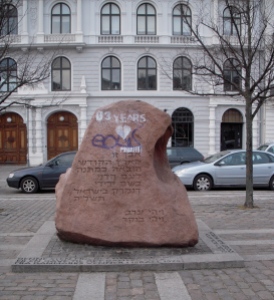by Kayla Green
Many experiences come to mind when one imagines a trip to Copenhagen, including seeing the famous statue of Hans Christian Andersen’s Little Mermaid, visiting ornate castles and indulging in decadent smorgasbords. However, what is not as well known is the rich Jewish history and multitude of Jewish sights at the fingertips of any tourist visiting Denmark’s capital.
The Danish-Jewish community has been thriving for 400 years and is the oldest in Scandinavia. Today there are about 7,000 Jews in Denmark, the majority of whom live in Copenhagen. Denmark’s Jews range in origin from Spain and Poland to Germany and Russia.
The Danish Jewish Museum gives a good first taste of Jewish Copenhagen. The building was designed by Daniel Libeskind, whose Studio design study was selected in February 2003 as the master site plan for the rebuilding of the World Trade Center Site, and who also designed Berlin’s Jewish Museum. The museum itself is truly a sight to behold—in true Libeskind style, the architecture and décor are ultra-modern, from the sloped blond-wood walls to the interactive screens that provide visitors with additional information and videos. At the entrance of the museum, there is a video describing the Jewish community in Denmark in which Libeskind, who is of Polish-Jewish descent, discusses the flourishing community. Libeskind based the museum’s architectural design on the idea of mitzvah to symbolize the rescue of Danish Jews in 1943 and the peaceful coexistence of Jews in Denmark.
The rescue on which the museum is based truly exemplifies the relationship between Denmark and its Jewish community. In October 1943, when Hitler ordered that Danish Jews be arrested and deported, many Danes took part in a collective effort to evacuate their country’s Jews to nearby neutral Sweden. The rescue allowed 7,000 members of Denmark’s Jewish population to avoid capture by the Nazis while 481 were sent to Thresienstadt. The rescue, or “Mitzvah,” is considered to be one of the largest actions of collective resistance in the countries occupied by Nazi Germany. Over 99% of Denmark’s Jewish population survived the Holocaust.
The memory of this astonishing resistance, as well as the thankfulness of the global Jewish community, is represented by Israeli artist Bernard Reder’s sculpture, “Wounded Woman,” located in Churchill Park behind the Museum of Danish Resistance. Reder’s passion for the subject is obvious in the piece, which depicts a group of intertwined stone nude female figures twisted together in strong support. The sculpture, unveiled in 1969, was presented by the State of Israel to the Danish people in appreciation of their support.
Aside from the Danish Jewish Museum and the “Wounded Woman,” Copenhagen boasts several other symbols of the positive relationship between Denmark and its Jewish community. The Copenhagen synagogue is situated in the oldest part of the city, in a building constructed in 1830-1833 based on drawings by Professor G.H. Hetsch, who was also responsible for the design of St. Ansgar’s, Copenhagen’s Catholic cathedral. The synagogue sits behind a high gate—its brown façade blends well with its neighbors, but the gold Hebrew lettering notifies passersby of its Jewish heritage.
One of the most exceptional sights in Copenhagen is Israel’s Square. The small, centrally located park contains a large memorial stone, erected in 1975 with the following inscription: “This stone from the Holy Land is a gift to the Danish People from friends of Denmark in Israel 1975 – And night fell and morning came”. More than anything, this memorial displays that the positive sentiment that characterized the relationship between Jews and Denmark in the past still exists, and will continue to do so.


4 thoughts on “Denmark’s Jewish Heritage”
Thanks for this fascinating information, found it informative and enlightening.
kay-kay you are something!!! what a wonderful piece. like Denmark you are wonderful. Eric.
I look forward to reading your experiences abroad and you deliver. Never having been to Copenhagen, this information is a first for me. Thank you, Kayla, you make both past and present come alive and a note to explore and contemplate when I visit.